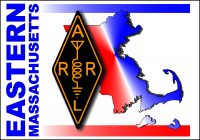New England Area Ham – Electronic Flea Market 8-1-03
W1GSL writes:
LAST UPDATE 8-1-03 de W1GSLList is normally updated twice a month - look for the latest version
Additions/ Corrections via Internet w1gsl@mit.edu
US Mail W1GSL POB 397082 MIT Br Cambridge MA 02139
(c)2003 W1GSL SASE for updated copy as issued.
unlimited reproduction permitted in entirety
*******************************************************************************New England Area Ham - Electronic Flea Market *** DATES *** 2003 P 1 of 2
All events are Ham Radio/ Electronic related except ~_____~
*******************************************************************************
2003 Contact Source
~~~~~~~~~~~~~~~~~~~~~~~~~~~~~~~~~~~~~~~~~~~~~~~~~~~~~~~~~~~~~~~~~~~~~~~~~~~~~~~
2 Aug Essex Jct VT BARC @EssexHS $5@8 $10/T@7$4w/oT Renee N1UXK 802 893 76602 Aug Union ME PenBayARC Scott KB1DSW 207 354 6809 A+
2 Aug E Greemwich RI FARC+NEW+S Antique $10@8 Nancy 401 885 0545 W+
9 Aug St Albans ME PARC George WA1JMM 207 965 8864 A
17 Aug Flea at MIT Nick 617 253 3776 F
Third Sunday April thru October17 Aug Adams MA NBARC Alan K1SAV 413 446 8742 A+
24 Aug Enfield CT East V-UHF Conf @Radisson $5B$10S Mark K1MAP 413 566 2445 W
6 Sept BallstonSpa NY SCRACES fri6P $5+5/T+15cmp Darlene N2XQG 518 587 2385
6 Sept Point-Claire PQ WIARC @StJohnCh $5@9 $10@7 Janusz VE2ZHP 450 659 5181 R
7 Sept Bethpage NY LIMARC @Briarcliffe $6@? $15/S Brian WB2YMC 516 822 0673
13 Sept Windsor CT VintgeR Museum @33 MechanicsSt $12/S@6 John 860 673 0518
14 Sept S Dartmouth MA SEMARA Sell@6 $2@7 Tim N1TI 508 758 3680 F
14 Sept Newtown CT CARA @TownHall @7Sell 8:30Buy John W1JMA 203 438 6782
20 Sept Forestdale RI RIFMRS @VFW rt146 8A flea+auct Rick K1KYI 401 725 7507
20 Sept Waterbury VT CVARC @Armory I89x10 $5@8 $10/T Tom WA1YNU 802 476 3116 F
21 Sept Flea at MIT Nick 617 253 3776 F
27 Sept Orange MA MARC @Elks rt2A $3@8 $15/T/tg@6 John AE1B 978 249 5980
3,4 Oct Hopkinton NH HossTraders @FG x7 I89 Joe K1RQG 207 469 3492 W
5 Oct Queens NY HallofSciARC $5@9 $10/S Stephen WB2KDG 718 898 5599 F
11 Oct Nashua NH NE Antique RC $5@8 $1@9 @ StStan's Hall Joe 978 343 5726 F
11 Oct Lake Placid NY NNYARA NNY Conv Tom WB2KLD 518 827 4800 A
12 Oct Wallingford CT Nutmeg Conv Andrew N1XXU 203 235 8440 A
~~~~~~~~~~~~~~~~~~~~~~~~~~~~~~~~~~~~~~~~~~~~~~~~~~~~~~~~~~~~~~~~~~~~~~~~~~~~~~~
LAST UPDATE 8-1-03 de W1GSL http://mit.edu/w1gsl/Public/ne-fleas P 1 of 2
*******************************************************************************
Additions/ Corrections via e-Mail w1gsl@mit.edu ***
Page 3 Electronic distribution only. This page has the overflow if any P3
from the paper version.
*******************************************************************************
2003 Contact Source
~~~~~~~~~~~~~~~~~~~~~~~~~~~~~~~~~~~~~~~~~~~~~~~~~~~~~~~~~~~~~~~~~~~~~~~~~~~~~~~
~~~~~~~~~~~~~~~~~~~~~~~~~~~~~~~~~~~~~~~~~~~~~~~~~~~~~~~~~~~~~~~~~~~~~~~~~~~~~~~
LAST UPDATE 8-1-03 de W1GSL P 3
List is normally updated twice a month - look for the latest version
Additions/ Corrections via Internet w1gsl@mit.edu
US Mail W1GSL POB 397082 MIT Br Cambridge MA 02139
(c)2003 W1GSL SASE for updated copy as issued.
unlimited reproduction permitted in entirety
*******************************************************************************This list has been posted... as a service of the individual home page
owners, to the following WWW sites.http://flealist.senie.com/
http://mit.edu/w1gsl/Public/ne-fleas
http://www.k1ttt.net/flea.html
http://www.connix.com/~wz1v/ne-fleas.html
http://www.k1dwu.net/flealist.html
http://www.mmra.org/~mmra/flealist.htm
http://www.qsl.net/vhfnews/ne-fleas.html
http://uhavax.hartford.edu/~newsvhf/ne-fleas.htmlList is normally updated twice a month - look for the latest version
Be sure to check for the latest version as updating is under the control
of the page owner.* You can have the list e-mailed directly to you as it is updated. *
* Just send a request to be added to the distribution to w1gsl@mit.edu *73 Steve F
W1GSL***********************************************************************
New England Area Ham - Electronic Flea Market *** DATES *** P4
Links to New England Hamfest Web Sites (c) 2003 W1GSL
***********************************************************************
This section is only included in the electronic distribution.Cambridge MA Flea at MIT http://www.swapfest.us +
Hopkinton NH Hosstraders http://www.qsl.net/k1rqg/
Amherst MA Mt. Tom ARC http://www.mtara.org/hamfest/flea.html
Adams MA N BerkshireARC http://www.nobarc.org/hamfest
Boxborough MA NE ARRL Conv http://www.boxboro.org/
Framingham MA FARA http://www.fara.org/
Newton MA Waltham ARA Auction http://www.wara64.org/auction/
S Dartmouth MA SEMARA http://www.semara.org/flea/fleamkt.htm +
Whately MA FranklinCARC http://www.fcarc.org/flea.html
Enfield CT VHF/UHF Conf http://www.newsvhf.com +
Southington CT SARA http://www.chetbacon.com/sara.htm
Wallingford CT Nutmeg CT Conv http://www.qsl.net/nutmeghamfest/
Lewiston ME AARC http://www.dlois.com/mainearrl/convent.htm
Portland ME PAWA http://www.qsl.net/pawa/fleamarket.html +
Henniker NH CVRC http://www.qsl.net/k1bke/ +
Bergen NJ BARA http://www.bara.org/
Lake Placid NY NNY ARA http://www.geocities.com/nnyara/
Lindenhurst NY ToB ARES http://www.tobares.org/hamfest.html +
Long Island NY LIMARC http://www.limarc.org/fest.htm +
Massapequa NY GSB ARA http://www.gsbarc.org/flyermay03.pdf +
Queens NY Hall of Science http://www.qsl.net/hosarc/hamfest.html
Rochester NY AWA http://www.antiquewireless.org/
Greenwich RI Fidelity ARC http://users.ids.net/~newsm/dates.html
Essex Junction VT Burlington ARC http://www.vtstetson.net/fest02.pdf
Milton VT RANV VT Conv http://www.ranv.org/milton.html
Montreal PQ MARC http://www.marc.qc.ca/fest.html
Montreal PQ WIARC http://www.pubnix.net/wiarc/hamfest.htm
Sorel-Tracy PQ CRAS-T http://www.hamfest.qc.ca/
St Therese PQ CRALL http://www.ve2crl.qc.ca/hamfest2002.htm
Canada RAC List http://rac.eton.ca/data/racfleas.taf?function=form
Phila. Area VARA List http://www.qsl.net/w2vtm/hamfest.html +
USA ARRL List http://www.arrl.org/hamfests.html
W1NXC Wins ARRL Instructor of the Year Award
 Edmond (“Ed”) Weiss, W1NXC has been named by ARRL as the winner of the 2002 Herb S. Brier Instructor of the Year award. Weiss, a long-time member of the Framingham Amateur Radio Association, was nominated by fellow members.
Edmond (“Ed”) Weiss, W1NXC has been named by ARRL as the winner of the 2002 Herb S. Brier Instructor of the Year award. Weiss, a long-time member of the Framingham Amateur Radio Association, was nominated by fellow members.
Weiss is retired from the New England Telephone Company. He worked as a transmission engineer. W1NXC holds an Amateur Extra and commercial General Class license. He is also a registered professional engineer in Massachusetts.
Weiss served in World War II as a radio officer and is a member of the Society of Wireless Pioneers. The head instructor for Framingham Amateur Radio Association since 1978, Weiss has also completed the ARRL Emergency Communications courses and is a certified instructor for level I, II, and III.
“It is indeed an honor for someone to win the Herb S. Brier award,” said Phil Temples, K9HI, Eastern Massachusetts Section Manager. “Nominees from across the country must demonstrate a high success rate by way of numbers of students who pass their license exams and a high percentage of those who begin a course who successfully complete it.” Temples added, “candidates must also display extraordinary personal commitment. The endorsements and testimonials supplied by fellow club members and students are key in winning the award. I know that Ed’s fellow club members hold him in high esteem. He’s very deserving of this award.”
“Herb S. Brier, W9AD, long-time CQ Novice Editor, represented the spirit of effective, caring Amateur Radio instruction. The ARRL sponsors this award, in conjunction with the Lake County (IN) Amateur Radio Club, in his memory to recognize the very best in volunteer Amateur Radio instruction,” according to the ARRL web site.
Weiss will receive an engraved plaque and a $100 credit for purchase of ARRL publications. The award will be co-presented at a special “FARA Night Out” activity by K9HI and ARRL New England Division Director Tom Frenaye, K1KI.
[I knew the late Herb Brier while growing up in Indiana. Herb’s cheery demeaneor on the air and selfless dedication to all newcomers to the hobby was legendary. Way to go, Ed! -K9HI]
CEMARC BBQ, ARES Workshop at SEMARA 8/9/03
 Frank Murphy, N1DHW writes:
Frank Murphy, N1DHW writes:
Time is getting close for the BBQ at the Southeastern MA ARA on August 9th. If you are planning to attend just the BBQ lunch, please reply to this email, or call me, Frank N1DHW, 617-491-8451 so SEMARA can plan for food. If you plan to attend just the BBQ, arrive about 10:00 a.m.
Spread the word to those in your club who might want to attend. You are on the CEMARC mail list and others in the club depend on YOU to forward CEMARC info. Talk it up on the repeater.
Better yet, attend the all day ARES Workshop being conducted at SEMARA that day, and really have a day out. The Workshop is from 9:00 – 4:30, with a 2 hour break for the BBQ lunch.
Workshop details, and directions to SEMARA can be found at:
http://users.rcn.com/rmacedo/emrgshop.htm
Hope to see you there.
Framingham ARA 440 Repeater QRV
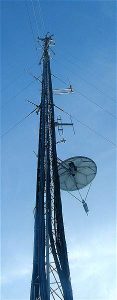 FARA’s long awaited 440 repeater is up and running.
FARA’s long awaited 440 repeater is up and running.
It is currently a stand-alone repeater but, hopefully, within a month or so it will be tied in with 147.15. The repeater is in Hopkinton, at Rick Zach’s site.
* Frequency: 448.025
* PL (tone): 88.5
Please try it out. We want to check coverage. [Full story] Thanks, www.fara.org
Boston Third Annual Triathlon Help Needed
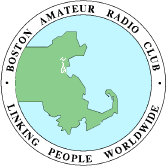 Bob Salow, WA1IDA writes:
Bob Salow, WA1IDA writes:
We have been asked again to support emergency communications for the third annual Triathlon held in Boston. Formally known as the “Monster Challenge, Tri-Boston,” this world-class race is sponsored by Monster.com (the job-finding web site) for the benefit of the AIDS Action Committee. The event is basically unchanged from last year.
The triathlon consists of a swim in the harbor around the World Trade Center (WTC) in South Boston; bike from there through downtown Boston, Charlestown, across and around Cambridge, and back to the WTC; and run from the WTC into and around the Marine Industrial Park and finish at the WTC. Exhausting? Yes for the racers, no for us hams.
Date: Sunday, 31 August 2003
Ham start: 0600
Ham finish: 0930 to 1100
The ham start time is governed by road closures and access to the station locations. It is important to be at the assigned locations on time (even if you are the first one there) – the triathletes move very fast (I don’t know how they do it), so the course is occupied quickly.
Yes, I know it is the day before Labor Day. The upside is it starts early and ends early, leaving plenty of weekend enjoyment time. Your help is greatly needed to continue this as a superb event and to uphold our reputation for dependable support. Our assignments consist of monitoring hazardous and critical locations along the course, and the medical/support stations. As we did last year, we plan to use a 2-meter repeater and/or a 70-cm repeater. Hand-held with a good battery is the way to go.
If you can help, please contact me as soon as possible. I will email the assignments and more detail early, and for most, you can go directly to your station. If you reply from an email address other than the best for you, let me know. Also, please send me a phone number. Parking should be available very close to each location. Feel free to contact me if you have questions.
Thanks and 73,
Bob Salow, WA1IDA
508.650.9440
wa1ida@arrl.net
ARRL Volunteer Resources Committee Report: STM’s Comments
 Jim Ward, N1LKJ writes:
Jim Ward, N1LKJ writes:
I found the VRC Report regarding traffic disturbing.
We all know that since the inception of electronic mail, traffic handling has been seriously effected. When I first got into traffic handling and later, became Net Manager of Boston’s Eastern Massachusetts Two Meter Net, we used to average 400 checkins per month. After more and more hams got into the computer age, the checkins dropped to about 280 each month. Checkins have remained at that figure ever since.
There is no question that e-mail has hurt, but hams have stepped forward by creating messages like welcoming new hams to the hobby. How can anyone find these message offensive and label them “canned traffic,” “crap traffic,” etc.? They’re missing an opportunity to deliver this traffic and welcome a new ham to the hobby. They’re missing an opportunity to talk to a new ham and tell him or her about local clubs, the ARRL, ARES, and RACES. There was even one SM who complained about birthday and holiday traffic. I guess Scrooge and the Mad Hatter still live.
Gil, W1GMF, one of the stations who originates “welcome to ham radio” traffic receives hundreds of messages from hams to whom this traffic is delivered. The hams thank him for sending it. STMs from all over the country have thanked Gil for what he and other hams like him are doing. Sure, there are a few disgruntled STMs–but they very much in the minority.
The NTS is alive and well. It remains a training place for ARES and RACES operators to enhance their skills in copying, sending and acting as a Net Control Station. I can only speak for my area of operation. The local nets, the First Region Net and the Eastern Area Net are all handling a lot of traffic by dedicated traffic handlers.
To those who wish to “bury us” I would say, “You are a little premature.”
Jim Ward N1LKJ
ARRL Section Traffic Manager,
Eastern Massachusetts Section
Volunteer Resources Committee Report: STM’s Comments
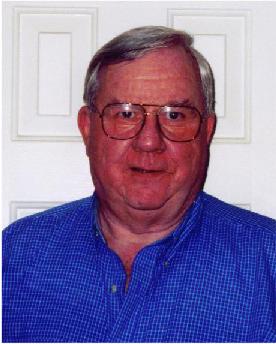 EMa Section Traffic Manager Jim Ward, N1LKJ posts some insightful comments in response to the recent ARRL VRC report on the EMa NTS web site at http://nts.ema.arrl.org/article.php?sid=16.
EMa Section Traffic Manager Jim Ward, N1LKJ posts some insightful comments in response to the recent ARRL VRC report on the EMa NTS web site at http://nts.ema.arrl.org/article.php?sid=16.
APRS Tracker Boxes Needed!
 Bruce Pigott, KC1US writes:
Bruce Pigott, KC1US writes:
“The communications coordinator for the Red Cross First Aid Committee has asked for help in tracking rescue launches during the Head of the Charles Regatta in Cambridge, Massachusetts. (See also http://ema.arrl.org/article.php?sid=176.)
We are looking for seven autonomous trackers available on October 17-19 (Friday through Sunday) that can be strapped down in power boats and turned on by hams. They will be removed from the launches each night. Two receiving setups will be at Net Control and the Cambridge Emergency Operations Center. The trackers have to be mostly waterproof and use a minimum of switches. We want use a UHF channel to avoid problems on VHF. This will be an excellent opportunity to display another aspect of amateur radio to multiple public service agencies. With 7,000 rowers and an estimated 300,000 spectators, our presence is a crucial part of the event.
All suggestions about APRS use or volunteers for the event will be appreciated.
Thank you and 73,
Bruce Pigott KC1US
kc1us03@amateur-radio.net
Hurricane Workshop, Bourne MA 7/30/03
 KD1CY writes:
KD1CY writes:
Hello to all….
The following statement concerns a Hurricane Workshop in Bourne, Massachusetts that is open to the public. This is similiar to the workshop that was done in New Bedford, Massachusetts in early May. Below is the specific information on this workshop, all are welcome to attend.
NOUS41 KBOX 281343
PNSBOX
PUBLIC INFORMATION STATEMENT
NATIONAL WEATHER SERVICE TAUNTON MA
945 AM EDT MON JUL 28 2003
…HURRICANE AWARENESS WORKSHOP WEDNESDAY EVENING IN BOURNE…
COME AND JOIN US FOR A FREE HURRICANE AWARENESS WORKSHOP FOR THE GENERAL PUBLIC AND PUBLIC SAFETY OFFICIALS…WEDNESDAY JULY 30TH FROM 7 PM TO 830 PM AT THE BOURNE HIGH SCHOOL AUDITORIUM. THE HIGH SCHOOL IS LOCATED 1/4 MILE FROM THE BOURNE BRIDGE/STATE POLICE BARRACKS OFF TROWBRIDGE ROAD. THE PROGRAM IS BEING SPONSORED BY THE NATIONAL WEATHER SERVICE – TAUNTON MA
MASSACHUSETTS EMERGENCY MANAGEMENT AGENCY BOURNE LOCAL EMERGENCY PLANNING COMMITTEE CAPE COD REGIONAL CHAMBER OF COMMERCE AMERICAN RED CROSS NSTAR ELECTRIC COMPANY
IT HAS BEEN 49 YEARS SINCE NEW ENGLAND HAS BEEN HIT BY A MAJOR (CATEGORY 3) HURRICANE AND 12 YEARS SINCE A HURRICANE OF ANY KIND HAS MADE LANDFALL HERE. THIS WORKSHOP WILL DISCUSS THE REALITIES OF NEW ENGLAND HURRICANES AND WILL HELP YOU PREPARE FOR THIS TYPE OF DISASTER.
AGAIN…7 PM AT THE BOURNE HIGH SCHOOL THIS WEDNESDAY…JULY 30TH. TROWBRIDGE ROAD RUNS ALONG THE SIDE OF THE MASSACHUSETTS STATE POLICE BARRACKS AT THE BASE OF THE BOURNE BRIDGE ROTARY CIRCLE. FOLLOW TROWBRIDGE ROAD 1/4 MILE DOWN ON THE LEFT HAND SIDE TO BOURNE HIGH SCHOOL…IMMEDIATELY AFTER THE PEEBLES ELEMENTARY SCHOOL. PROCEED UP THE DRIVEWAY FOR PARKING AT THE BETH BOURNE AUDITORIUM AT THE BOURNE HIGH SCHOOL. ADMISSION IS FREE. SEE YOU THERE.
$$
FIELD
Respectfully Submitted,
Robert Macedo (KD1CY)
ARES SKYWARN Coordinator
Southeast Massachusetts ARES District Emergency Coordinator
SEMARA ARES Emergency Coordinator
Pager #: (508) 354-3142
Home Phone #: (508) 994-1875 (After 6 PM)
Home/Data #: (508) 997-4503 (After 6 PM)
Work Phone #: 1-800-445-2588 Ext.: 72929 (8 AM-5 PM)
Email Address: rmacedo@rcn.com
http://users.rcn.com/rmacedo
VRC’s Field Organization Report Released
 The ARRL Volunteer Resources Committee has released its final report to the Board of Directors. The long-awaited report concludes that the “state of the Field Organization is ‘fair'” even though it is “not what it should be” in order to “meet overall obligations to provide emergency communications at the national level.”
The ARRL Volunteer Resources Committee has released its final report to the Board of Directors. The long-awaited report concludes that the “state of the Field Organization is ‘fair'” even though it is “not what it should be” in order to “meet overall obligations to provide emergency communications at the national level.”
The report is based in part on the results of questionnaires returned by many of the field organization’s Section Managers.
To better understand the report, read the accompanying Section Manager Survey Results.
N1IQI Awarded Brass Pounders League Award
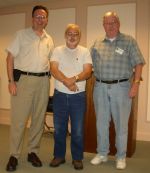 The presentation of a BPL bronze medallion from the ARRL was made to Loren Pimental, N1IQI at the July 15, 2003 meeting of the Massasoit Amateur Radio Association.
The presentation of a BPL bronze medallion from the ARRL was made to Loren Pimental, N1IQI at the July 15, 2003 meeting of the Massasoit Amateur Radio Association.
N1IQI Awarded Brass Pounders League Award

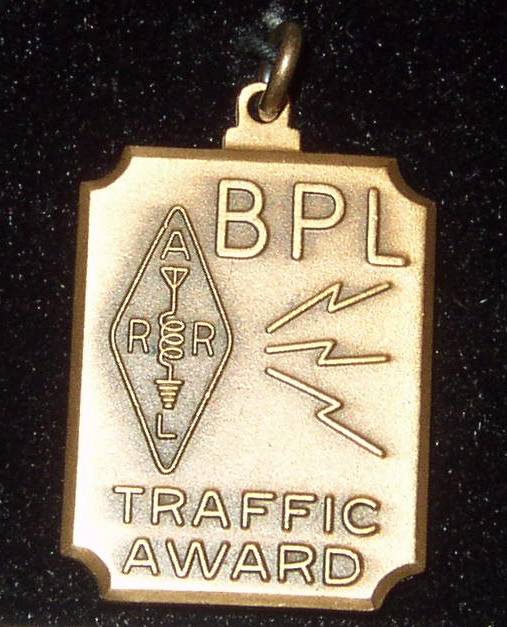 W1GMF wrote:
W1GMF wrote:
The presentation of a BPL bronze medallion from the ARRL was made to Loren Pimental, N1IQI at the July 15, 2003 meeting of the Massasoit Amateur Radio Association for points assessed from traffic handling over a period of 6 months.
Presenting the award to Loren (center) were Phil Temples, K9HI, ARRL Section Manager (left) and Jim Ward, N1LKJ, Section Traffic Manager (right).
Congratulations, Loren, on this recognition of your participation in this important aspect of amateur radio.
Head of the Charles Regatta Volunteers Requested
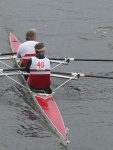 Jeff Arnold writes:
Jeff Arnold writes:
Once again, on behalf of the American Red Cross First Aid Station Committee, I would like to ask for your help in working the 2003 Running of the Head of the Charles Regatta.
This year the dates are Friday-Sunday, October 17, 18, 19.
Please mark your calendars and get back to me as soon as you can. Please pass this e-mail on to others so that we can bring in some new blood to our team.
Please reply to this e-mail and reply with:
name, call sign
address
e-mail
which of the 3 days you can work,
& preference to land or boat position.
I am starting this early so that everyone can get this marked on their calendar.
Jeff
**************************************************
Jeffrey Arnold
RWJeffA@comcast.net
N1FWV@amsat.org
http://home.comcast.net/~rwjeffa/
**************************************************
“ADA Classic” Finds Ham Support Invaluable
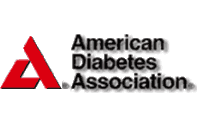 Amateur volunters performed valuable public service by giving their time and effort to assist in the two- and seven-day “ADA Classic.” The ride raised funds for the American Diabetes Assocation and traversed portions of MA, NH, ME and VT. The Classic was supported by 17 volunteers and the staff, including 15 amateur radio operators. The support team also included four bike mechanics with vans, an EMT in his own vehicle, three rest stop vehicles and two “SAG” wagons.
Amateur volunters performed valuable public service by giving their time and effort to assist in the two- and seven-day “ADA Classic.” The ride raised funds for the American Diabetes Assocation and traversed portions of MA, NH, ME and VT. The Classic was supported by 17 volunteers and the staff, including 15 amateur radio operators. The support team also included four bike mechanics with vans, an EMT in his own vehicle, three rest stop vehicles and two “SAG” wagons.
Mike Goldberg, K1LJN recounted their efforts.
“On July 11, Jim Evans, N1HTS, Ted Haskell, W1EID, Bill Lacy, KB1ICA, Steve Witley, KB1HMZ, Dennis Howland, KB1IDQ and I showed up at Woburn Mall and began to distribute tasks among each other. Some of us headed to pick up a 34-foot cargo truck to haul the gear. The others went to pick up the cargo and window vans. All were returned to the Mall to be filled with water jugs, water coolers, ice chests, first aid supplies, cases of snack foods, route vehicle handbooks, paper towels, pens, etc.” Goldberg added, “We installed two-meter mobile equipment in each vehicle. In addition there were two large pickups. All were loaded by 5 p.m., except for 400 pounds of ice which was loaded later.”
The Woburn Mall donated the use of a vacant store which was used for registration of about 150 riders for The New England Classic, 150 and 550.
Goldberg resports the group had one major medical incident, along with assorted falls and bee stings.
The riders efforts netted $256,000 for ADA Research and Education.
Amateurs who participated in the two-day event were:
Charlie Reed, N1VI
Maureen Polson, N1RBE
Seven-day participants were:
Jim Evans, N1HTS
Mike Goldberg, K1LJN
Scotti Goldberg, N1PUI
Ted Haskell, W1EID
Bill Lacy, KB1ICA
Dave Humt, EMT, N1XAJ
Al Kinnon, KD1EA
Faith Linsky, N1RUN
Tracey Thompson, KB1EFT
Paul Magrath, K1KZL (Chief Bike Mech)
Don Salls, N1ZYF (Top Kick)
Steve Witley, KB1HMZ (Gear Guy)
Dennis Howland, KB1IDQ (ADA Staff)
June NTS Traffic Totals Posted
 The section traffic totals have been posted to http://nts.ema.arrl.org by Section Traffic Manager Jim Ward, N1LKJ.
The section traffic totals have been posted to http://nts.ema.arrl.org by Section Traffic Manager Jim Ward, N1LKJ.
Congrats to W1GMF, KW1U, N1LKJ and N1IQI for top activity report totals in June.
New MA RACES Plan Available
 Tom Kinahan, N1CPE wrote:
Tom Kinahan, N1CPE wrote:
We’ve spent some time updating procedures for the Massachusetts RACES program, including defining the Massachusetts Emergency Frequency Plan or MEFP, updating net operation activities requiring the usage of and defining the terms “Over”, “Out” and “Break” in the course of a controlled net to indicate what the NCS requests, a list of available VHF Simplex frequencies to pass traffic or other coordination, updated contact information on RACES, ARES, SKYWARN and MARS leadership, updated sample RACES appointment forms and updated club contact information courtesy of the ARRL.
Please download a copy and keep it with your station records.
This document is dated July 1, 2003 and approved by myself, Steve Finks W1SBF the State Communications Officer, and Stephen McGrail the Director of the Massachusetts Emergency Management Agency. Accept no substitutes or previous versions at this time.
Get your copy at:
http://www.qsl.net/n1cpe/racesplan.pdf
or
http://n1cpe.dnsalias.net:81/racesplan.pdf
Please forward this message as needed for the widest distribution among Amateur Radio Operators in Massachusetts.
Thank you,
Tom Kinahan N1CPE
Massachusetts State RACES Radio Officer
Cape Cod ARES Summer Exercise 7/19/03
 Members of the Cape Cod ARES will conduct a summer communications exercise Saturday, July 19. The exercise, dubbed “Operation Long Haul” will test the ability of “EOCs, three field teams and multiple zone-based home relay stations to provide general communcations and relay coverage of the operational zones.” See http://ares.ema.arrl.org/article.php?sid=105 for the details.
Members of the Cape Cod ARES will conduct a summer communications exercise Saturday, July 19. The exercise, dubbed “Operation Long Haul” will test the ability of “EOCs, three field teams and multiple zone-based home relay stations to provide general communcations and relay coverage of the operational zones.” See http://ares.ema.arrl.org/article.php?sid=105 for the details.
KD1SM Public Service List – July 17, 2003
PSLIST July 17, 2003
Public Service Volunteer Opportunities in the New England Division
Listing public events at which Amateur Radio communications is providing
a public service and for which additional volunteers from the Amateur
Community are needed and welcome. Please contact the person listed to
identify how you may serve and what equipment you may need to bring.
The most up-to-date copy of this list is maintained as
http://purl.org/hamradio/publicservice/nediv
**** Every event listed is looking for communications volunteers ****
Date Location Event Contact Tel/Email
Aug 9 Concord NH NH Classic MS 150 bike ride David KA1VJU 603-398-3667
to 10 to Henniker NH and return ka1vju@cnharc.org
Sep 12 Provincetown MA MS Challenge Walk John N1PYN 508-588-3250
to Dennis MA n1pyn@arrl.net
Sep 13 Dennis MA MS Challenge Walk John N1PYN 508-588-3250
to Truro MA n1pyn@arrl.net
Sep 14 Dennis MA MS Challenge Walk John N1PYN 508-588-3250
to Brewster MA n1pyn@arrl.net
Sep 21 Madison CT Bike Tour for MS Scott AA1WM 203-676-1016
to Moodus CT aa1wm@arrl.net
Sep 22 Moodus CT Bike Tour for MS Scott AA1WM 203-676-1016
to Madison CT aa1wm@arrl.net
Oct 11 Pepperell MA Fall Classic Soccer John KB1HDO 978-772-5406
to 13 kb1hdo@hotmail.com
Oct 17 Boston MA Head of the Charles Regatta Jeff N1FWV 978-536-2842
to 19 rwjeffa@attbi.com
This list is published periodically as demand warrants by Stan KD1LE
and Ralph KD1SM. Our usual distribution is via packet to NEBBS, via
Internet mail to the arrl-nediv-list and ema-arrl distribution lists,
and on the World Wide Web (see URL above). If other mailing list
owners wish us to distribute via their lists we will be happy to
oblige. Permission is herewith granted to republish this list in
its entirety provided credit is given to the authors and the URL
below is included. Send comments, corrections, and updates to:
(via packet) KD1SM@K1UGM.#EMA.MA.USA,
(via Internet) KD1SM@ARRL.NET.
We make an attempt to confirm entries with the coordinator unless the
information is from another published source. We very much appreciate
the assistance we have been receiving from our 'scouts'; everyone is
welcome to send us postings.
Refer to http://purl.org/hamradio/publicservice/nediv for the most
recent version of the PSLIST.
Cape Cod ARES Drill 7/19/03
Members of the Cape Cod ARES [held its] summer communications exercise Saturday, July 19. The exercise, dubbed “Operation Long Haul” will test the ability of “EOCs, three field teams and multiple zone-based home relay stations to provide general communcations and relay coverage of the operational zones.”
According to Cape and Islands District Emergency Coordinator Frank O’Laughlin, WQ1O, the exercise will utilize high frequency Near Vertical Incidence Skywave (NVIS), VHF/UHF FM and SSB. O’Laughlin adds, “we’ll attempt communications with other ARES districts if the opportunity arises.”
The drill will be the first CCARES exercise in which a field team conducts an NCS operation on the 6 meter band.
A description of Operation Long Haul can be found in the ARES web site links under “Departments/Programs | Training”.
